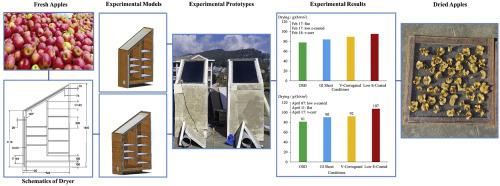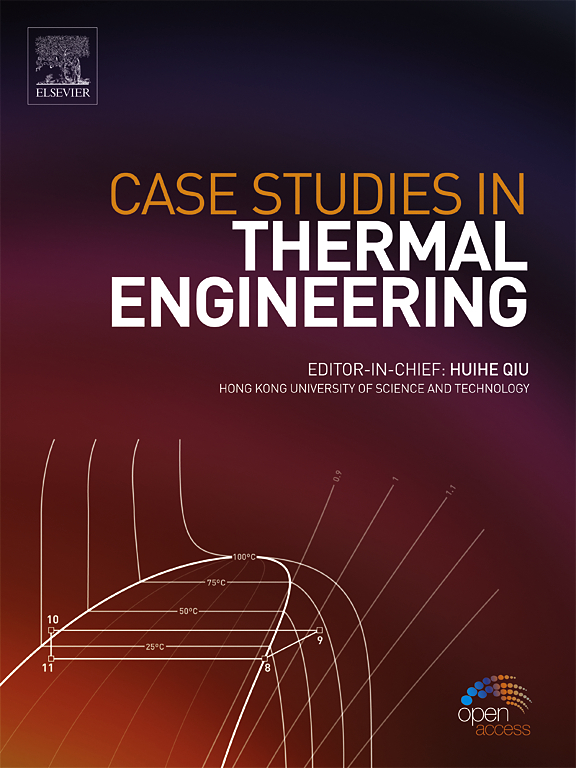Investigation of thermodynamics performance of a heat exchanger-incorporated solar dryer equipped with double-pass flat, v-corrugated, and low-e coated collectors for drying applications
IF 6.4
2区 工程技术
Q1 THERMODYNAMICS
引用次数: 0
Abstract
In this study, a solar dryer incorporating a flat plate heat exchanger to recover heat from exhaust air was investigated to explore the usability of different types of collectors in the system. Their usability was further evaluated through economic and environmental analyses. Moreover, the thermodynamic performance of the solar dryers was evaluated under two weather conditions in Nepal. Apple drying experiments were conducted for 8 h from 09:00 to 17:00 from February to April 2023 on solar dryers and with open sun drying (OSD) in Dhulikhel, Nepal. The results showed that the low emissivity (low-e) coated aluminum collector was more efficient in terms of collector efficiency and drying rate than collectors with flat or v-corrugated GI absorbers. The average collector efficiency and drying rate were found to be 89 % and 107 g/(h × m2) using the low-e coated aluminum collectors, while the values were 50 % and 84 g/(h × m2) for the GI sheet collector. The results indicated a slight improvement in the performance of v-corrugated collectors, with values of 53 % and 89 g/(h × m2). The drying rate for OSD was found to be 78 g/(h × m2), which was lower than for the dryers with all collectors used in this study. In terms of economic analysis, the dryer equipped with the low-e coated collector was found to be superior, with a payback time of 1.61 years compared to the dryers with flat or v-corrugated GI collectors. Reducing the thermal losses due to radiation by using the low-e coated absorber was shown to be more important than increasing the absorber area using v-corrugated GI sheets.

用于干燥应用的装有双通道平板、V 型波纹和低辐射涂层集热器的热交换器太阳能干燥器的热力学性能研究
在这项研究中,我们调查了一种太阳能干燥器,该干燥器采用平板热交换器从废气中回收热量,以探索系统中不同类型集热器的可用性。通过经济和环境分析,进一步评估了它们的可用性。此外,还在尼泊尔的两种天气条件下对太阳能干燥器的热力学性能进行了评估。2023 年 2 月至 4 月,在尼泊尔 Dhulikhel 的太阳能烘干机和露天日晒(OSD)上进行了 8 小时(9:00 至 17:00)的苹果烘干实验。结果表明,就集热器效率和干燥速率而言,涂有低辐射率(low-e)涂层的铝制集热器比带有平面或 V 形波纹 GI 吸收器的集热器更有效。使用低辐射铝涂层集热器的平均集热器效率和干燥率分别为 89 % 和 107 g/(h × m2),而使用 GI 片材集热器的平均集热器效率和干燥率分别为 50 % 和 84 g/(h × m2)。结果表明,V 型波纹集热器的性能略有提高,其值分别为 53 % 和 89 g/(h × m2)。OSD 的干燥速率为 78 g/(h × m2),低于本研究中使用的所有集热器的干燥机。在经济分析方面,配备低辐射涂层集热器的烘干机比配备平面或 V 型波纹 GI 集热器的烘干机更优越,投资回收期为 1.61 年。使用低辐射涂层吸收器减少辐射造成的热损失比使用 V 形波纹 GI 板增加吸收器面积更重要。
本文章由计算机程序翻译,如有差异,请以英文原文为准。
求助全文
约1分钟内获得全文
求助全文
来源期刊

Case Studies in Thermal Engineering
Chemical Engineering-Fluid Flow and Transfer Processes
CiteScore
8.60
自引率
11.80%
发文量
812
审稿时长
76 days
期刊介绍:
Case Studies in Thermal Engineering provides a forum for the rapid publication of short, structured Case Studies in Thermal Engineering and related Short Communications. It provides an essential compendium of case studies for researchers and practitioners in the field of thermal engineering and others who are interested in aspects of thermal engineering cases that could affect other engineering processes. The journal not only publishes new and novel case studies, but also provides a forum for the publication of high quality descriptions of classic thermal engineering problems. The scope of the journal includes case studies of thermal engineering problems in components, devices and systems using existing experimental and numerical techniques in the areas of mechanical, aerospace, chemical, medical, thermal management for electronics, heat exchangers, regeneration, solar thermal energy, thermal storage, building energy conservation, and power generation. Case studies of thermal problems in other areas will also be considered.
 求助内容:
求助内容: 应助结果提醒方式:
应助结果提醒方式:


